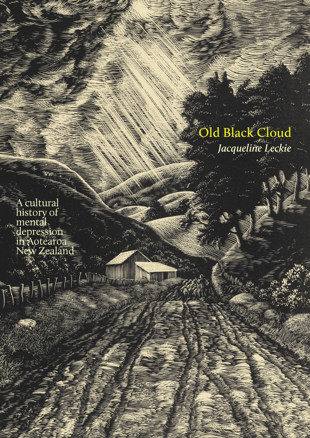Nicholas Reid reviews Old Black Cloud: A cultural history of mental depression in Aotearoa New Zealand by Jacqueline Leckie on Reid’s Reader:
‘Jacqueline Leckie’s Old Black Cloud deals with mental depression, but it is not a manual telling us how to deal with mental depression or what therapies should be consulted by the afflicted . Rather it is what the sub-title says it is: “A cultural history of mental depression in Aotearoa New Zealand”. Old Black Cloud covers attitudes towards mental depression and attempted remedies that were used or tried in New Zealand from the earliest nineteenth century to the present time.
Her Introduction strikes a personal note. In the 1990s, mental depression was widely believed to be caused by a chemical imbalance in the brain. But Jacqueline Leckie records pain and depression brought into her family, not by chemical imbalance in the brain but by the death of her mother. She was advised to take Prozac, which she did, but more depression fell on her when she was made redundant from her university position. The clear point is that mental depression can be triggered in many ways, not least by external circumstances. There is now a backlash against the medicalisation of mental depression. As she works her way through the history of mental depression in New Zealand, Leckie cites many documented cases of severe depression, using the names of real sufferers only from the nineteenth and very early twentieth centuries. Thereafter, for privacy reasons, cases are given pseudonyms with the exception of creative people whose travails are well known.
Her first task (Chapter 1) is to define what exactly mental depression is and how it is named. First taking the obvious route of separating mental depression from economic depression, she considers the older term melancholia which, by the mid-19th century, had come to mean severe mental conditions, such as mania. She quotes Janet Oppenheim’s statement which emphasised the similarities comparing melancholia and depression: “Nervous breakdown, a popular name for incapacitating depression, is not a specific disease that can be traced to a single cause. It is an abstract concept, encompassing many symptoms that vary from one patient to another, with invariably devastating effect. The characteristic sense of overwhelming hopelessness, emptiness, impotence, and uselessness, the incapacity to focus attention or reach decisions, the obsessive thoughts and fears, the diminished self-esteem, the extreme lethargy, and the inability to take interest or pleasure in any aspect of life make existence scarcely tolerable.” (Chap. 1, p.22) The term “manic-depressive insanity” was devised in the 1880s. In New Zealand, a “neuro-pathological” laboratory was set up in Dunedin’s hospital – but it was only in 1953 that a trained psychiatrist was appointed in Dunedin’s hospital. And in Auckland it was only when the Auckland Medical School was set up in 1968 that a psychiatrist was brought into an Auckland hospital. Of course there had been “Mental Hospitals” in New Zealand before that – more concerned with care that cure – and in the late 19th century there were many discussions about melancholia which was often called “neurasthenia”. Some spoke of “involuntary melancholia” referring to women’s “climacteric” [what we would now call menopause]. Gradually the term “melancholia” was phased out as “depression” took over – although “melancholia” was still used in references to delusions, fantasy etc. sometimes masking what we would now call schizophrenia. In the late 19th – early 20th centuries, many doctors understood main causes of depression as alcohol, masturbation and post-natal depression. Since then, of course, there have been many attempts to describe what exactly mental depression is. Jacqueline Leckie quotes one academic description from the 1990s which goes thus: “A major depressive disorder entailed an individual: (1) experiencing at least one or two of the following symptoms during a two-week period – a depressed mood most of the day nearly every day, and a marked loss of interest in all or most usual activities; and (2) having at least four symptoms every day or most days – a change from previous functioning significant weight loss or gain, insomnia or oversleeping, psychomotor agitation or retardation, fatigue or loss of energy, feelings of worthlessness or excessive/ inappropriate guilt, diminished ability to think or concentrate, or indecisiveness, recurrent thoughts of death or suicidal, recurrent thought of death or suicidal thought/actions.” (Chap. 1, p.46) While this gives a reasonable description of depression, it is now regarded as inadequate for not considering cultural nuances - the differences between different ethnicities.
Having given descriptions of mental depression, Leckie than turns to specific types of mental depression in New Zealand starting, under the heading “Rawakiwaki” (in Chapter 2), with mental depression among Maori in the 19th century. A healer like Waata Pihikete Kukutai understood Pakeha medicine, but tried to persuade Pakeha doctors that not all Pakeha remedies would really help Maori. He was ignored. In his own healing he often used traditional remedies. Leckie notes that while Maori could be broken in spirit by Makutu (a curse), and some chose Whakamomori (suicide) as a remedy, the real depression that plagued Maori was loss of land [confiscated by the government], isolation from others, the death of forebears and alienation from their iwi. The hard fact was that their world had become alien to them. Bringing this issue to the present age, Leckie notes: “International Indigenous literature refers to ‘cultural depression’, which is sometimes described as ‘trying to live in two worlds and fitting into neither.’ ” (Chap. 2, p.64) This was the Maori experience that has persisted. Even now, Maori men are unlikely to ask for help over mental issues.’
Read the rest of the review here.


